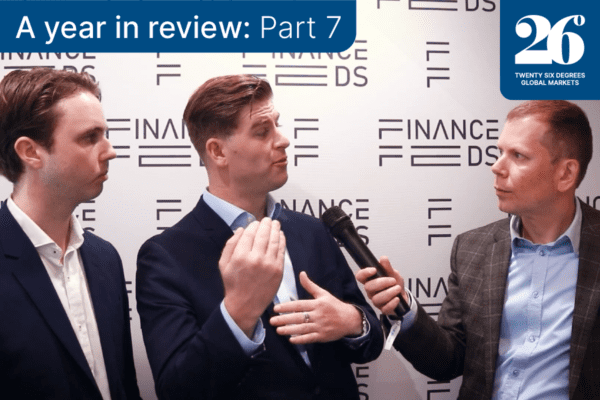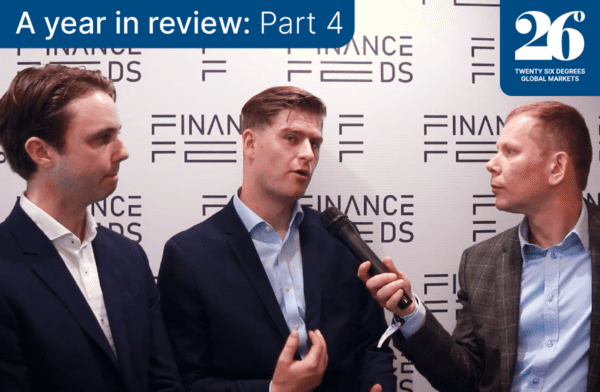



A Year in Review: Risk and margin requirements over the next 12 months
Nikolai Isayev
I wanted to ask you guys, where you see the industry heading in 2024, particularly with respect to prime brokerage and access to credit. With respect to prime brokerage I think the real question is, are we going to see further consolidation in the prime brokerage space? which has been discussed, I think, extensively this year. And what do you guys think will happen to access to credit? I know I have gotten James Alexander’s opinion on that earlier this year.
Lochlan White
Yeah, absolutely. I’ll jump in. I mean, we’d love to speak about this for an hour, to be honest, because it’s, sorry, I know it’s something that’s honestly, I’d love to hear what everyone in this room would say to that question, because from our point of view, what we’ve seen from the top down from the Tier 1 bank prime brokers, you know, margin requirements are increasing NOP capacities are decreasing at times in certain areas due to, I guess, the riskiness of the asset classes, or the particular instruments that we’re focusing on. But it is, I think, it’s already begun to happen. for the last eighteen months, where true Prime of Primes like ourselves that have Tier 1 bank prime broker relationships are beginning to pass on, or let’s say, reflect the banking conditions that we’re obliged to meet.
Ultimately, the prime brokerage game is one of a balance sheet where we subsidise, you know, the margin requirements that we have from the Tier 1 prime brokers, and our retail broker clients have to understand that those are increasing. And I would love to understand, you know, and hear other people’s perspectives because there is a bit of an educational piece, when people are perhaps surprised if we focus on gold, which is, you know, the most traded instrument at the moment, the fact that, you know, bank prime broker margin requirements start from, you know, 5% and go up from there.
There have been some recent stories that I’m sure a lot of people are aware of, where they’ve got themselves into trouble by not managing that risk as carefully as they probably should. So I think what we’ll see over the next 12 months is a continuation of what we’ve just said.
James Meek
I think I mean, you know, as you said, you’ve spoken to James before, I think you maybe spoken to Gavin as well. We’ve always been of the opinion that the bank prime brokers, the bank Tier 1 brokers are eventually going to be pulling out of this market due to capital requirement that doesn’t make this business sort of efficient for them.
So in the first sense, there’s a gap for us to fill, 26 Degrees there’s a 26 Degrees sized gap somewhere in there to be a non-bank prime broker for all of these clients that need capacity, that need the space. I think in the last few years, especially like Lochlan was saying about the gold margins, there’s a genuine disconnect between what the prime brokers are pricing and their pricing of risk, and what the retail market expects. And I think what’s probably, the first question you asked us has exacerbated that disconnect because brokers are moving so, so far towards the B-book model, they’re internalising 90% of flow and 90, 95% of positions even. If you’re internalising your positions, you don’t need to worry about what margin requirement is at your prime broker. And if those margin requirements are slowly creeping up, like they have been – especially in gold, then that can almost take you by surprise. Because, you’ve been B-booking and then all of a sudden the volatility drops. You need to start hedging more. You need to move back to that traditional A-book model, and oh crap, margins are, you know, much higher than they were last time I looked.
So I think if the low volatility continues and if the A-book model comes back, the traditional A-book model comes back a bit, then I think that disconnect is going to slowly squeeze. And during that disconnect that’s definitely going to push some players out of the game, I think. And cause a consolidation of the client base and you know, curb the capacity. You know, we don’t take on any retail broker that exists. We focus on, you know, the right brokers that understand what we’re doing on our side, appreciate it, respect it, and make the most of what we give them. I think we both agree that over the next two years, probably even three years, we’ll continue on this trajectory where they are, you know, externalizing or A-booking a little bit more percentage of their total book size, They have to understand that those with smaller balance sheets or those that aren’t willing to put their balance sheet forward, will need to consider doing so. Otherwise, there will be some further consolidation.
Expert voices
Watch the interview's highlights






